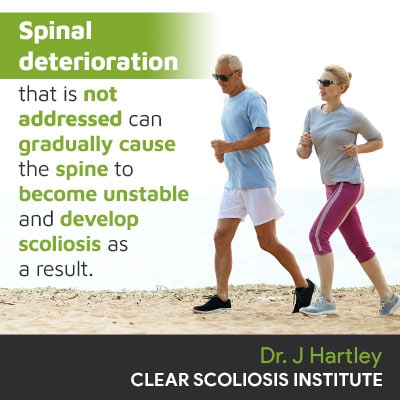
While scoliosis is more prevalent in children and adolescents, it also affects adults. The two most common types of adult scoliosis are adolescent scoliosis in the adult (ASA) and degenerative scoliosis, also known as de novo scoliosis; both forms have their own unique causes and treatment needs.
While scoliosis is progressive, it is highly treatable, for both young and adult patients. In adulthood, the condition becomes compressive, and while each case is different, with no treatment guarantees, corrective results can be achieved through proactive and customized treatment plans.
Before moving on to the specifics of scoliosis treatment in adults, let’s first define the condition and discuss some of its important characteristics.
In order for a scoliosis diagnosis to be given, certain parameters have to be met; scoliosis is an unnatural sideways curvature of the spine, with rotation, and a minimum Cobb angle measurement of 10 degrees.
Part of the diagnostic process involves further classifying the condition based on important patient/condition characteristics: patient age, cause (if known), curvature location, and condition severity.
Patient age is important because it determines whether or not the condition is likely to be painful, and also indicates potential rates of progression.
Adolescents and children are at risk for rapid-phase progression because growth/development is the condition’s main trigger for progression; adults have the trigger of growth removed so tend to progress at a slower rate, although age-related spinal degeneration can increase that rate.
Condition severity is a key factor and is determined by a patient’s Cobb angle:
Scoliosis is often deemed a complex condition to treat, and this has a few reasons: progression (scoliosis has it in its very nature to worsen over time), conditions can range from mild to moderate and severe, it can develop anywhere along the spine, and there are multiple condition types with different underlying causes.
As a progressive condition, a goal of treatment, both in adolescents and adults, is to prevent increasing condition severity, escalating symptoms, and the need for more invasive treatment in the future.
When it comes to the main condition types affecting adults, we’re talking about adolescent scoliosis in the adult (ASA) and degenerative scoliosis.
While many consider scoliosis to be a child and adolescent condition, it also affects adults.
While treatment goals always include reducing a scoliotic curve, when it comes to treating adult scoliosis, the focus of AIS treatment (counteracting progression and working towards significant curvature reductions) can shift to restoring spinal flexibility, and stabilizing the spine, and pain management.

Adolescent Scoliosis in the Adult
Adolescent idiopathic scoliosis (AIS) is the most prevalent type of scoliosis, diagnosed between the ages of 10 and 18.
The idiopathic designation means not clearly associated with a single causative source, and the condition is, instead, thought to be multifactorial, meaning caused by a number of variables that can vary from one patient to the next.
As mentioned, scoliosis doesn’t become compressive until adulthood once growth has stopped and the lengthening motion of a growing spine no longer counteracts the compressive force of the scoliotic curve.
While scoliosis is known to cause a degree of muscle pain in adolescents, in general, the condition isn’t commonly painful, and in mild forms, it’s rare that the condition causes functional deficits.
In addition, related postural changes (the main symptom of scoliosis in adolescents) can be subtle and difficult for an average person, not specifically trained in recognizing the condition’s early signs, to recognize.
These characteristics of AIS make early detection a challenge, and it’s not uncommon for adolescents to live for years with the condition unaware, until reaching adulthood when the condition becomes compressive, and pain brings these adults in for a diagnosis and treatment.
The unfortunate reality is that had these patients received a diagnosis and proactive treatment in adolescence, their spines would be in far better shape than by the time I see them; that being said, it is never too late to work towards correcting scoliosis in adults.
To be clear, scoliosis is incurable, so when I say correct, I mean achieve corrective results in the form of a curvature reduction, but once a person is diagnosed with scoliosis, they have it for life, and after successful treatment, work will still have to be done to sustain those results.
The next most common condition type diagnosed in adults is degenerative scoliosis.
Degenerative Scoliosis
Also known as de novo scoliosis, this is degenerative scoliosis that develops fresh in adulthood with no prior history of the condition, unlike ASA.
Degenerative scoliosis is most prevalent in adults over 40 and is more common in women due to hormone and bone-density changes related to menopause.
As we age, the body starts to degenerate, and the spine is no exception.
In order for the spine to function optimally, it needs to maintain its natural curves and alignment, but as the spine starts to experience degenerative changes, this becomes increasingly difficult.
The spine is made up of vertebrae (bones) stacked on top of one another, separated by intervertebral discs; most often, it’s the discs that are the first spinal structures to feel the effects of deterioration.
The discs provide the spine with structure, work together to facilitate flexible movement, provide cushioning between adjacent vertebrae, and act as the spine’s shock absorbers.
When the discs start to deteriorate, they can change shape, lose height, become desiccated, and affect the positioning of adjacent vertebrae and the spine’s ability to maintain its natural and healthy curves.
In addition to natural age-related spinal degeneration, the cumulative effect of certain lifestyle choices can also play a role in increasing the rate of spinal degeneration: not maintaining a healthy weight or activity level, chronic poor posture, and repeatedly lifting heavy objects incorrectly and straining the back.
So how can you correct scoliosis in adults?
In many cases of ASA, adults don’t experience pain or functional deficits until their 30s, or even later, when natural age-related spinal degeneration tends to become more of a factor.
While each case is unique, most adults with ASA have a progressive rate of approximately one degree a year, and while that can sound minor, the cumulative effect of even incremental increases can amount to a significant curvature increase over time.
As adults pass into the 50-60 age range, it’s likely their progressive rate will increase alongside age-related spinal degeneration: putting ASA patients, in this age range, at a progressive rate similar to adults with degenerative scoliosis.
As a CLEAR-certified scoliosis chiropractor, I believe in the merits of proactive treatment applied as close to the time of diagnosis as possible.
While there are no treatment guarantees, the sooner treatment is started, the more likely it is to be successful at achieving corrective results.
My ASA patients are treated with a conservative chiropractic-centered treatment approach that combines multiple treatment disciplines to craft fully-customized treatment plans.
Through condition-specific chiropractic care, a variety of therapies including scoliosis-specific physical therapy and exercises, and bracing for stabilization and pain management, corrective results can be achieved in adults.
Condition-specific chiropractic care can use a variety of techniques, such as gentle manual adjustments, to work towards repositioning the most-tilted vertebrae back into a healthier and more natural alignment with the rest of the spine, restoring as much of the spine’s natural and healthy curves as possible.
Physical therapy and scoliosis-specific exercises (SSEs) can help with increasing core strength so the spine is optimally supported by its surrounding muscles, and they can also help activate certain areas of the brain to improve brain-body communication and facilitate postural remodeling.
Bracing can be an effective tool for pain relief in adults, slowing progression, and stabilizing the spine.
As mentioned, adult degenerative scoliosis commonly involves the deterioration of one or more spinal discs, so treatment will focus on addressing the condition’s underlying cause, restoring disc function, and preventing further damage.
As the discs are the largest structures in the body to not have their own vascular supply, meaning no direct path in and out for the transport/absorption of oxygen and important nutrients needed for cellular repair, reversing disc damage can be a lengthy process, just as the process of disc degeneration tends to be gradual.

Adult scoliosis can cause pain, a loss of height, and postural shifting, including a prominent lean to one side, and in severe cases, lung impairment and digestive issues can develop.
The majority of ADS cases involve a 30-degree curve or less, at the time of diagnosis, but remember, as a progressive condition, where scoliosis is at the time of diagnosis is not indicative of where it will stay, especially if proactive treatment isn’t applied.
In fact, most of my patients are classified as moderate because it’s in the moderate severity level that symptoms tend to become more noticeable.
Again, while each case is unique, on average, patients with moderate ADS, whose conditions are left untreated, are likely to progress at a rate of 0.5 to 3 degrees a year, so over a 10- 20-year period, that can add up to significant progression and a large scoliotic curve.
Although it’s never too late for treatment, it’s far simpler to treat small curves while they are still small, before significant progression has occurred, because we know that progression increases spinal rigidity, making the spine less responsive to treatment, and over time, the body can adjust to the presence of an unnatural spinal curve.
When it comes to treating adult degenerative scoliosis patients, condition-specific chiropractic care and gentle manual adjustments can help with adjusting the position of affected vertebrae, and keeping the facet joint of the vertebrae mobile, which reduces pain.
Manual adjustments can also help with disc issues as adjusting the position of adjacent vertebrae can impact disc shape, health, and function.
Corrective bracing can be used in the treatment of ADS by reducing motion and stress on the spine’s facet joints, which helps with spinal stabilization, and also reduces pain.
Scoliosis-specific exercises can also be helpful with increasing spinal strength, mobility, and keeping the spine’s surrounding muscles loose, flexible, and strong so they can provide the spine with optimal support, taking pressure off the discs and joints of the spine.
In addition, SSEs can help improve circulation in the areas surrounding a damaged disc, making much-needed nutrients for repair and restoration available to the discs through osmosis.
So can you correct scoliosis in adults: yes, corrective results can be achieved when proactive treatment is applied.
While the focus of significant curvature reductions, and managing progression, shapes the treatment of scoliosis in adolescents, this can shift to preserving spinal function, preventing further damage, stabilizing the spine, and pain management when treating scoliosis in adults.
While there are multiple types of scoliosis, the two most prevalent forms to affect adults are adolescent scoliosis in the adult (ASA) and adult degenerative scoliosis (ADS).
As a CLEAR-certified scoliosis chiropractor, I follow the CLEAR treatment protocols which involve treating and assessing the entire spine, and integrating multiple scoliosis-specific treatment disciplines such as chiropractic care, physical therapy, and corrective bracing so the condition can be impacted on multiple levels.
The best time for scoliosis treatment in adults is always now; leaving a condition untreated can lead to significant progression over time, decreased spinal stability and deterioration, increasing pain and postural deviation, and the need for more invasive treatment in the future.

CLEAR provides a unique and innovative way of understanding scoliosis. Sign up to receive facts and information you won’t find anywhere else.
